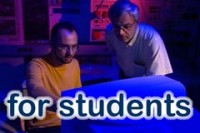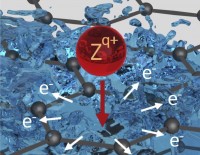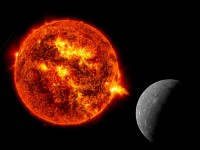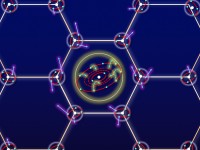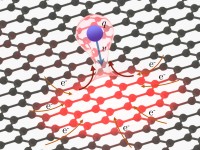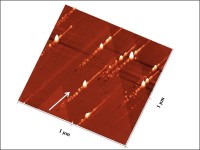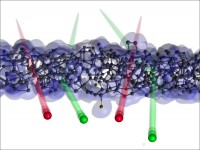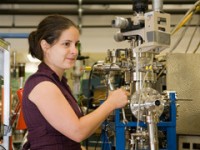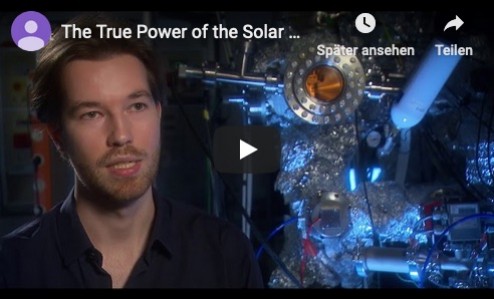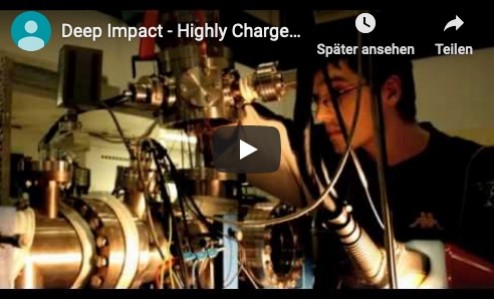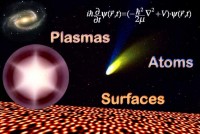This is an old revision of the document!
Atomic and Plasma Physics
Research Highlights
Slow electrons for cancer treatment
Ion beam radiation therapy uses complicated atomic-physical effects to fight cancer cells. Our group has now identified a new mechanism that directly emits low energy electrons, which are very effective in destroying cancer cells. An effect that has received little attention in this context plays an important role, the so-called “Interatomic Coulomb Decay” (ICD). Read more
The True Power of the Solar Wind
The solar wind, a steady stream of mainly protons and few multiply charged heavier ions from the sun, causes significant erosion upon impact on the surface of atmosphere-less planets like Mercury or on the moon. In a recent paper in Icarus we now show that previous models of this process are incomplete. The effects of solar wind bombardment are in some cases much more drastic than previously thought. The role of solar wind constituents heavier than protons and in particular the role of the particles charge state has so far been underestimated. Read more or watch the TV report in the 3SAT magazine nano.
The solution to an old riddle
For more than 20 years atomic physicists have speculated about the mechanism, which allows “hollow atoms” to deexcited with a few femtoseconds. Our experiments with highly charged ions and graphene now show that the reason is an effect so far not accounted for: the so-called “interatomic coulomb decay”. Our results have been published in the journal Physical Review Letters and have been highlighted there as “editors' suggestion”. Read more.
Graphene able to transport huge currents on the nano scale
In this work, published by Nature Communications, we demonstrate that graphene, a two-dimensional form of carbon, is able to provide tens of electrons for charge neutralization of a slow highly charged ion within a few femtoseconds only. This in turn results in extremely high current densities, which the graphene can withstand without suffering permanent damage. Read more.
Meteorite Impact on a Nano Scale
A meteorite impacting the earth under a grazing angle of incidence can do a lot of damage; it may travel a long way, carving a trench into the ground until it finally penetrates the surface. The impact site may be vaporized, there can be large areas of molten ground. All that remains is a crater, some debris, and an extensive trail of devastation on both sides of the impact site. Hitting a surface with high-energy, heavy ions has quite similar effects – only on a much smaller scale. In Journal of Physics: Condensed Matter we investigated the microscopic structures which are formed when ions are fired at crystals at oblique angles of incidence and could shed light on the underlying formation mechanism. Read more.
Highly Charged Ions Sent through Nano-Membranes
A bullet fired through a block of wood will slow down. In a similar way, ions are decelerated when they pass through a solid material: the thicker the material, the larger the energy loss will be. However, this picture breaks down in ultra-thin target materials, which only consist of a few layers of atoms. This was demonstrated by our group in collaboration with the Helmholtzzentrum Dresden-Rossendorf. The results are reported in Physical Review Letters and 2D Materials. Read more.
High precision experiments for fusion research
A clean, eco-friendly and virtually inexhaustible source of energy: using nuclear fusion to produce electricity has been the dream of countless scientists for many years. However, until recently it has not been possible to construct a fusion reactor robust enough to withstand the enormous heat flux in the fusion plasma. To investigate this problem, a unique measuring device has been developed at the Institute of Applied Physics at TU Wien: One of the world’s most accurate scales. Read more.
Space Weathering on Mercury (3SAT magazine nano reports on our work)
Deep Impact - Highly charged ion research at TU Wien (an imagefilm designed and produced by our graduate students)
Research Statement
Research activities
Research activities in the “Atomic and Plasma Physics” group are focused on the interaction of (multi-charged) ion beams with matter (atoms, molecules, surfaces) both from a fundamental point of view and because of their relevance for plasma-wall interaction, fusion plasma diagnostics and material manipulations.
Funding
A major part of the research program is being carried out within Austrian fusion research program Fusion@ÖAW funded by the Horizon 2020 project EUROfusion. Our research is further funded by Austrian Fonds zur Förderung der wissenschaftlichen Forschung FWF, Austrian Academy of Sciences ÖAW and Friedrich Schiedel-Stiftung für Energietechnik. The group participated in the EU networks ITS LEIF (HPRI-CT-2005-026015) and was one of the member groups in the EU networks LEIF (HPRI-CT-1999-40012) and MCInet (HPRN-CT-2000-00027).
International collaborations
Our group is a member of the following international collaborations:
 EUROfusion (H2020)
EUROfusion (H2020)
 SPARC Collaboration at FAIR
SPARC Collaboration at FAIR
Impressum/Offenlegung gemäß § 25 Mediengesetz: Inhaber der Website ist das Institut für Angewandte Physik der TU Wien, 1040 Wien. Es gilt der Haftungsausschluss und die Datenschutzerklärung der TU Wien.




